
 |
|
|
#1 |
|
All the news that's fit to excerpt
Name: newsie
Location: who knows?
Join Date: Jun 2008 Motorcycle(s): only digital replicas Posts: Too much.
|
[motorcycle.com] - Church Of MO: 2006 Suzuki SV650S vs 2006 Kawasaki Ninja 650R
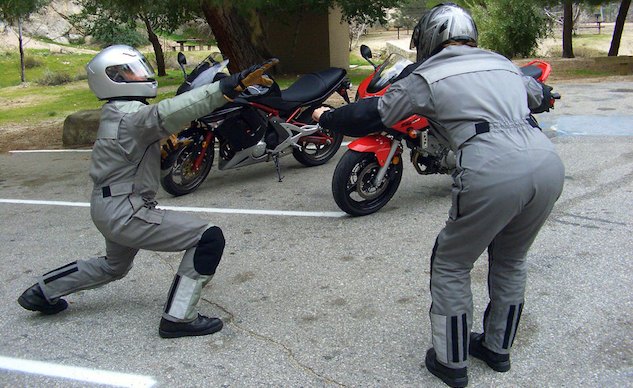 To celebrate*the*imminent*return of Suzuki’s*beloved SV650, as well as to prepare for similar upcoming shootouts betwixt the SV and its modern counterparts, we bring you this 2006 shootout pitting the SV650 against its*Kawasaki Ninja 650R nemesis. The Ninja 650*has been updated since this shootout ten years ago, and Honda now has a competitor in the form of the CBR650F. Who knows, to really stir the pot, maybe we’ll throw a KTM 690 Duke into the mix.* 2006 Suzuki SV650S V. 2006 Kawasaki Ninja 650R To SV or not SV, that is the question… By Gabe Ets-Hokin,*January 24, 2006 Today’s story starts way back in 1987, when Honda introduced an unpretentious little motorcycle with a mildly-tuned, liquid-cooled 647cc V-Twin engine in a rigid aluminum frame. Priced almost as high as its fully-faired and much more powerful cousin, the 600 Hurricane, the Hawk GT sold about as well as Ann Coulter t-shirts at a Phish concert. However, savvy enthusiasts quickly recognized that with a few choice suspension and engine modifications, the Hawk was an incredibly sweet-handling and fun bike that did double duty as a lightweight racer. Many racing clubs had classes filled completely with Honda Hawks, as no other manufacturer made a middleweight twin with the Hawk’s potential.  Alpinestars Attacks! Alpinestars Attacks!Last year, Kawasaki showed an interesting bike built for the European market. The ER-6n is a naked standard with a steel trellis frame and a sophisticated 650cc parallel-twin motor. Power output was claimed at 69.7 hp, clearly targeting the second-generation SV’s 71.1 claimed hp. The weird styling and lack of full fairing meant this bike probably would never come to American riders. Imagine our surprise when we got invited to the introduction for Kawasaki’s all-new for 2006 Ninja 650R. Pete’s day aboard the new bike revealed a nice-handling little bike that was let down only by budget suspension and braking components. We also found out that a unit would be available for a full test in just a few weeks. 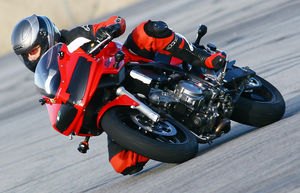 Who’s that lady? (who’s that lady?) Beautiful lady (who’s that lady?) Who’s that lady? (who’s that lady?) Beautiful lady (who’s that lady?)We knew our readers would want to know how this bike — the first serious competition for the SV available in the US — would do against the Suzuki twin, so we called up Suzuki and begged for an SV650 to test as well. All we had to decide was which flavor SV to compare it to. Some of us felt the standard SV would be a closer match, as the Kawi has tall bars that would feel very different from the S model’s clip-ons on a racetrack, where the other school of thought held the majority of readers would feel only bikes with fairings should be compared, as a buyer in the market for a faring-ed bike wouldn’t consider a naked, and vice-versa. In the end, the fairing people won, and Suzuki graciously and kindly gave up a fresh-from-the-crate 2006 SV650S. Both Publisher Sean Alexander and I are club racers and trackday junkies with many miles on SV650s, so we wanted to see how the two bikes stacked up on the racetrack. A few phone calls secured us a trip to the Streets of Willow racetrack, courtesy of Hyperclub trackdays, and a call to Michelin got us two new sets of Pilot Power street/trackday tires. After a week of all kinds of riding, from the track to the canyons, from bumpy LA freeways and city streets to the smooth sweepers of the Angeles Crest, we think we have enough data to have an intelligent opinion on who makes the best 650 twin streetbike. Does the Kawi have what it takes to unseat the SV from its middleweight-twins throne? The Contenders* 2006 Suzuki SV650S :: 71.15 hp :: $6,449 :: Friendly and Furious  Go ahead and call `em “beginner” bikes. Just make sure you know you’re faster than the guy who just bought one. Go ahead and call `em “beginner” bikes. Just make sure you know you’re faster than the guy who just bought one.If only a Vincent had such a good chassis. The SV’s “truss”-style frame was all-new for 2003, with a boxier, more creased appearance than the old one. It retained the aluminum swingarm and linkage-type rear suspension of the old bike, along with a 41 mm damper-rod fork. The front and rear suspensions are adjustable for preload only. Wheels are 3-spoke aluminum jobs shod with Dunlop D220s, a 120/60-17 in front followed 56.3″ behind by a 160/60-17 rear. Braking is handled by a trio of Tokico two-piston sliding-pin calipers and 290 mm front discs- the rear disc is 220 mm. Perched on top is 1980’s-esque bodywork with lots more sharp edges. Our 2006 was in a fetching shade of red, the bodywork contrasting nicely with the black frame and wheels. There are plenty of amenities, like a metal grabrail for your passenger and a hazard light. The LCD speedometer sits above the tachometer. As a bonus, you can view the coolant temperature and clock at the same time. The bike weighs in at a claimed dry weight of just 372 pounds. Aside from the Duran Duran-esque fairing and five extra Ben Franklins, the S differs from the standard version of the SV650 by having higher and more rearset footpegs, low clip-on handlebars, a slightly shorter swingarm, and taller gearing. It’s a complete package that looks like something much more powerful, expensive and sophisticated than it is, which partially explains the bike’s continuing success. What does the Ninja need to surpass it? 2006 Kawasaki EX650R :: 65.65 hp :: $6,299 :: Meet The New Kid  Gabe’s used to working in his underwear… Gabe’s used to working in his underwear…Lest Pete’s endurance of the long tech briefing go in vain, check out his coverage of* the 650R’s press introduction. If you’d rather have me give you a quick rundown, we’ll start with the motor. To inform you cynics out there, it’s not a bored-and-stroked EX500 motor. With a very oversquare 83 mm bore and 60 mm stroke, it’s a much more compact and modern design, with a cassette-style gearbox, semi-dry oil sump and liner-less cylinders to make it smaller than the 500. A 180-degree crank and balance shaft keep it smooth, and 38 mm injectors directed by a microprocessor-controlled engine management system keep it precisely fueled.  Gabe wears his underwear outside his clothes for the same reason Kawasaki’s engineers mounted the shock up high: easy adjustment. Gabe wears his underwear outside his clothes for the same reason Kawasaki’s engineers mounted the shock up high: easy adjustment.Brakes and wheels are nothing fancy. The six-spoke wheels sit just 55.3″ apart and carry Bridgestone BT-020s, a 120/70-17 in front and a 160/60-17 on the back hoop. The brake calipers look just like the two-piston units on the SV, but with the fashionable “petal”-style 300 mm rotors like those found on the ZX-6R and ZX-10R. It’s wrapped up in a muted, sophisticated fairing with a chest-height windscreen and integrated turn signals. Large integrated footpeg brackets carry the rider and passenger pegs on one immense unit, which will be challenging for racers to modify. The seat is carefully styled to blend in with the bike’s lines and is very narrow and low at the front, but thickly padded and wider at the rear. The handlebars are high and pulled back, but not too wide. …For $6,299, this is a nicely-finished, good-looking bike. Instrumentation is a bit spare, with no temperature gauge to distract the rider. There is a clock, dual tripmeters, and hazard lights as well. The build quality is just OK; the unit appears nicely designed, but the plastic is thin and some plastic panels have unsightly gaps and seams. Still, for $6,299, this is a nicely-finished, good-looking bike. The Test We officially started our test at curvaceous Streets of Willow racetrack in Rosamond, CA, with 14 turns simulating most of the kinds of corners a street rider will encounter, with pavement varying from Autobahn silky to Alabama chain-gang-repaired bumpy. There are two decent straights on the 1.8-mile long roadcourse, so every gear and throttle position gets a workout. Sean went out on the Suzuki first to scuff in the new tires. When he came back, he was all smiles, reliving memories of his roadracing exploits on his own SV650. “I already know which bike I like better” he said. I bundled myself up against the sub-50 degree High Desert chill and went out on the SV for a familiarization lap, but I didn’t get a good feel for the bike, with my*movement restricted by too many layers and my wrist restricted by fear of a cold racetrack. 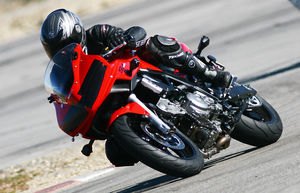 Pete getting busy with the SV. Pete getting busy with the SV.Next was a session of familiarization with the Ninja. Hopping aboard, I was struck by what is a very compact and street-oriented bike. The bars are very high and come back to meet your hands in a very neutral, almost upright position. The seat is high in the back, but narrow and low in the front, yet manages to not be too sloped forward. The pegs are pretty low. Overall, the rider is placed in a very comfortable position that doesn’t compromise control. The motor fires up willingly with no choke or drama. After a short warm-up period that involved a few coughs and sputters, the fuel injection seemed to work without trouble or flat spots. The gearbox works nicely too, as well as the low-effort, smooth-functioning cable-actuated clutch does. Bombing into the Street’s fast first turn, the Ninja was able to quickly get up to speed, thanks to the powerful midrange pull. “It likes to be short-shifted” was Sean’s advice, and indeed it’s a good strategy, as winding it out to the 11,000 rpm redline “just makes noise”, as a different tester noted. The nice torque surge in the mid-range lets you carry the bike a gear high, encouraging faster corner speeds. On a long straightaway, getting the bike up to 110 mph isn’t a problem; on a technical track like Streets, that’s as fast as novice and intermediate riders go on any size motorcycle. If the little Ninja has trouble on the track, it’s not power related. 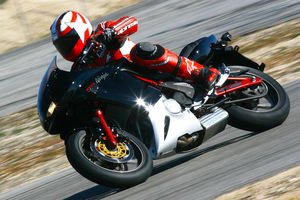 If anybody can get the most out of a motorcycle, it’s Sean. If anybody can get the most out of a motorcycle, it’s Sean.Nor does the chassis let the rider down. The short wheelbase, stout suspension and swingarm and sporty geometry balance light steering effort and high-speed stability. None of the testers noted any headshake all day, even on the bumpiest corners. What we did notice was the way the high handlebars made the front end feel indistinct during high-speed cornering. Ground clearance is also good, thanks to pegs that seem closer together than the SV’s and the underslung exhaust canister. Even though those pegs feel lower than the SV’s, they didn’t drag as frequently. This could be because they are closer together, or it could be that the SV has to have long peg feelers to keep its immense chrome exhaust can from dragging. Whatever the reason, the Ninja gives the rider a little more clearance, which should encourage nervous novices to charge the corners a little faster. Where the Ninja does disappoint on the racetrack is with brakes and suspension. Although the brakes are the same as the SV’s two-piston units, they somehow seem to require extra effort and provide less feel. The lack of better brakes on both bikes is glaring, considering the track-ready touches both of these bikes have, like lugs for swingarm stand spools on the swingarms and the stout frames and forks. The rear suspension is both undersprung and underdamped, which we tried to compensate for by putting the rear shock on the stiffest setting. This just made the back wheel hop around in bumpy corners, resulting in a loss of traction at least once for me. The front suspension seemed good enough to not complain about, but this is a bike that will need re-worked suspension to be truly safe and fun on a racetrack by all but the most novice riders. 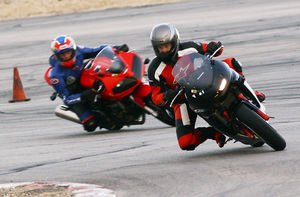 With a decent rider on board, the Ninja can keep ahead of most of the buffoons you meet at trackdays. With a decent rider on board, the Ninja can keep ahead of most of the buffoons you meet at trackdays.The Ninja was definitely a fun bike on the track, although there are few motorcycles not fun on a racetrack. The handling was forgiving; easy and precise at the same time, allowing the rider to make mistakes without landing him on his head. That’s how I felt until I hopped on the SV. All the fun and ease-of-use I felt on the Ninja faded away as I folded my legs up onto the higher rearsets and leaned forward to the low but not uncomfortable clip-on handlebars. It was time to rock-and-roll. The Suzuki feels right ergonomically, placing your body in a perfect position to control the bike on a racetrack without beating your body up too badly by placing too much weight on the wrists or cramping your knees. The motor revs smoothly, without a hitch from the nicely-dialed fuel injection. The Suzuki’s taller gearing makes it feel a bit softer in the midrange than the Ninja, but the more top-weighted powerband lets you rev the engine past 9,000 rpm, rewarding you with a bit more horsepower near the redline: at 10,250 rpm it’s still making over 65 hp. This broader powerband contributes to the SV’s superiority as a track bike, despite the Ninja making slightly more torque at lower rpms. 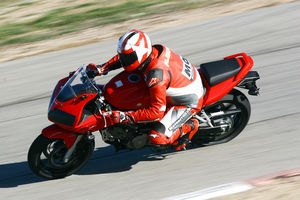 Sean said the spring wasn’t stiff enough on the SV. What he meant to say was that it’s not stiff enough for him. Sean said the spring wasn’t stiff enough on the SV. What he meant to say was that it’s not stiff enough for him.But the dominance doesn’t stop there. The brakes and suspension seem to work better as well. Although both of these bikes share the same brake calipers, and the Ninja has 10 mm larger-diameter discs, the SV is blessed with better feel and a stronger bite, resulting in more confidence in the brakes. The rear shock, although harder to adjust than the Ninja’s, uses a linkage, allowing it to react to bumps and whatnot with less travel, keeping the SV’s budget unit from revealing its lack of damping like the Ninja’s. We all thought the SV would be a clear choice for track-day enthusiasts and racers, but judging on lap time alone, it isn’t such a clear choice. We sent Publisher Alexander out with the mission of getting as many good timed laps on each bike as possible, and we watched him out on the track as he wrung every second he could out of the two bikes, passing just about every rider on the track with our little twins. 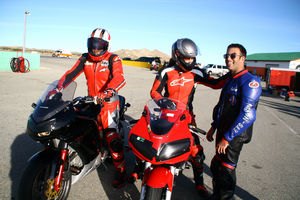 Gabe got beat by a girl! Gabe got beat by a girl!After several sessions, the SV was the winner, but barely: a best time of 1:30.54 on the Suzuki was a mere .72 seconds faster than the best Kawasaki lap, and selecting the five best lap times for each bike (to correct for heavy traffic in some of the Suzuki’s sessions) reveals a mere .38 seconds difference. Keep in mind that the track lap record — on any bike — is only about 12 seconds faster than a “beginner’s” bike with stock suspension and DOT street tires. Sure, Sean is good enough to run circles around most riders on an old Panhead with a nail in the front tire, but a determined racer — with some money thrown at suspension and other goodies — should be able to be competitive on the 650 Ninja, if racing a parallel twin is what she wants to do. The Word On the Street So the two bikes are about even, time-wise on the track, but which is better for street riding? Well, if the street is all about comfort, the Ninja would be a pretty clear winner. We all enjoyed the well thought-out ergonomics of the 650R. On a street ride, comfort is again the first thing you notice about that 650 Ninja. It’s a bike designed for smaller folks, with the bar very close to the rider and a small, narrow seat. But thanks to the low footpegs, big guys like Sean didn’t complain about the accommodations. The next thing you notice is how easy this bike is to ride, and at a relaxed street pace, how smooth and silky the motor is. Short gearing helps get the softer-engined Kawi up to speed quickly as well. The transmission has a light and smooth feel, allowing both clutchless upshifts and downshifts (although they’re not so good for the bike) alike. The light-feeling clutch and adjustable clutch lever ensure that smaller riders who haven’t yet built up a seasoned motorcyclist’s Kung-fu grip can still control and modulate the clutch easily. I’ve never felt 100% good about recommending the SV as a raw beginner’s machine, but the Kawi feels closer to the mark.  The Ninja’s sure to put a big, stupid grin on your face. The Ninja’s sure to put a big, stupid grin on your face.Riding around town, that easiness is still apparent. The low seat and high bars make maneuvering in tight urban spaces easy, keeping the rider’s head up and looking out for trouble. Although the bike’s claimed dry weight is significantly heavier than the SV’s, it feels lighter, perhaps because of the exhaust canister being tucked under the frame like that. The narrow design also aids lane-splitting, letting the rider sneak up between lines of cars like a real-life ninja. However, leave your throwing stars at home and don’t try to kill yourself if you get caught. On the freeway, the 650R is remarkably nice. The fairing offers the best of both worlds: it really keeps a lot of wind off the rider, but doesn’t catch side drafts that can blow around other lightweight, fully-faired motorcycles. The windscreen, though soft and floppy, doesn’t flutter noticeably at speed and puts the wind right at the top of your chest (if you’re 5’6″). Pete didn’t like the aesthetics of the screen and predicted a double-bubble type screen would be a hot-selling item for this machine. I say a Laminar Industries product will soon be available that will look great and offer even more wind protection. …high-speed freeway riding is where the 650R really excels. In fact, I would say high-speed freeway riding is where the 650R really excels. It’s remarkable to be able to sail along on the freeway at 80 or 90 mph on a “budget” motorcycle without it feeling like it will shake itself apart or that it’s using every last bit of power. Midrange throttle response is quite good, besting the 5 hp more-powerful SV in some impromptu roll-on contests in sixth gear. This is due to the shorter gearing of the 650R, but the motor is smooth enough so that even at about 7,500 rpm vibration is noticeable but not intrusive. The headlight is great, too, letting you ride at speed in the dark without riding past the headlight’s illumination. Mirrors work as well as the mirrors on the SV, which shouldn’t surprise anybody who’s noticed that they are, in fact, the exact same mirrors. They give a good view to the rear, and not just of your elbows. Fuel economy suffers a bit because of the shorter gearing. We observed 37.95 mpg from the Kawasaki, where the Suzuki used a gallon of gas to travel 39.36 miles. Having that extra midrange hit is definitely worth the four percent difference in fuel economy. Fuel range is better on the Suzuki, with its 4.5 gallon tank, unless you live in the Golden State, as Kalli-fornia models only hold 4.2 gallons, almost the same as the Kawi’s 4.1 gallon capacity. Twisty roads are good, clean fun on the 650R. That tall handlebar lets you flick the little bike into turns easily while still keeping your head up to see through the corners. The big fat midrange and short gearing conspire to keep the Ninja boiling through turn after turn. At a brisk street pace, the budget suspension is apparent, but it’s not as glaring as it is on the track, and I was able to keep Pete on the SV in sight easily. The cheap brakes are similarly not an issue on the street either: one or two fingers are all you need to slow the bike for most corners.  The Suzuki works well on city streets, but lacks the comfort of the Ninja. The Suzuki works well on city streets, but lacks the comfort of the Ninja.The first thing you notice going from the Ninja to the SV are the much lower bars and higher footpegs. If you’re used to sportbikes they feel mild; if you are coming from a cruiser or a Ninja 250 the difference will feel pronounced at first. However, it’s really a mild seating position compared to most sportbikes, with the bars a smidge above the top triple clamp and the pegs not high enough to cramp knees. Plopping it into gear with the not-as-nice-as-the Kawi’s six-speed gearbox and simple but smooth clutch reveals the second main difference; a motor that has a true V-twin sound and feel. You really might as well be on a small Ducati, with the sound of the 90-degree V rumbling behind you and the airbox making nice noises in front. Power delivery is different as well, with the thumping a little more pronounced and a powerband that starts way down around 3,000 rpm and doesn’t seem to taper off until you hit the rev limiter. With your head down and weight close to the bike, thanks to those low bars, the SV turns into a slice n’ dice tool so effective they should have an infomercial for it. (“Do you mean to tell me I can slice through traffic at 80 mph and never have to use the transmission? That’s incredible!”) The SV feels light, precise and totally predictable. Around town, it’s not as fun as the Ninja, since low speeds exacerbate the weight on your back and wrists, but it’s still plenty of fun with the flexible, quick-revving motor. The taller gearing means shifting, at city speeds, is optional.  A pair of mild and un-intimidating characters. A pair of mild and un-intimidating characters.On a twisty road the SV is almost magical. Its mild and un-intimidating character fools you into going much faster than is probably prudent, and the slight extra effort required by the lower bars encourages the rider to focus a bit more on his cornering technique. On a smooth, curving, high-speed road like Angeles Forest Highway, the SV can keep a good pace up at super-legal speeds. A good rider should need nothing more to keep up with almost anybody on anything. Church Of MO: 2006 Suzuki SV650S vs 2006 Kawasaki Ninja 650R appeared first on Motorcycle.com. Click here for full story...
__________________________________________________
I'm a bot. I don't need no stinkin' signature... |
|
|

|
 |
 Similar Threads
Similar Threads
|
||||
| Thread | Thread Starter | Forum | Replies | Last Post |
| [motorcycle.com] - Church Of MO 2006 BMW R 1200 GS Adventure | Ninjette Newsbot | Motorcycling News | 0 | August 30th, 2015 04:40 AM |
| [motorcycle.com] - Church Of MO Review: 2006 BMW K1200R | Ninjette Newsbot | Motorcycling News | 0 | January 4th, 2015 07:53 AM |
| [motorcycle.com] - Church Of MO 2006 Ducati S4Rs | Ninjette Newsbot | Motorcycling News | 0 | December 28th, 2014 04:41 AM |
| [motorcycle.com] - Church Of MO 2006 Suzuki GSR 600 | Ninjette Newsbot | Motorcycling News | 0 | October 5th, 2014 02:10 AM |
| [motorcyclistonline] - 2006-2009 Kawasaki Ninja 650R | Ninjette Newsbot | Motorcycling News | 0 | September 8th, 2010 05:14 PM |
|
|